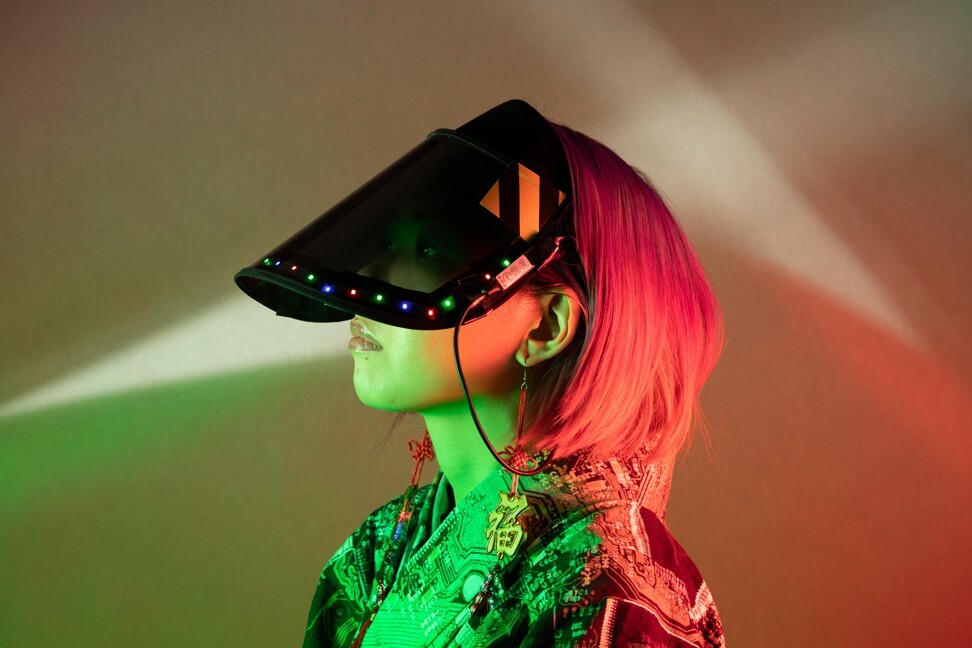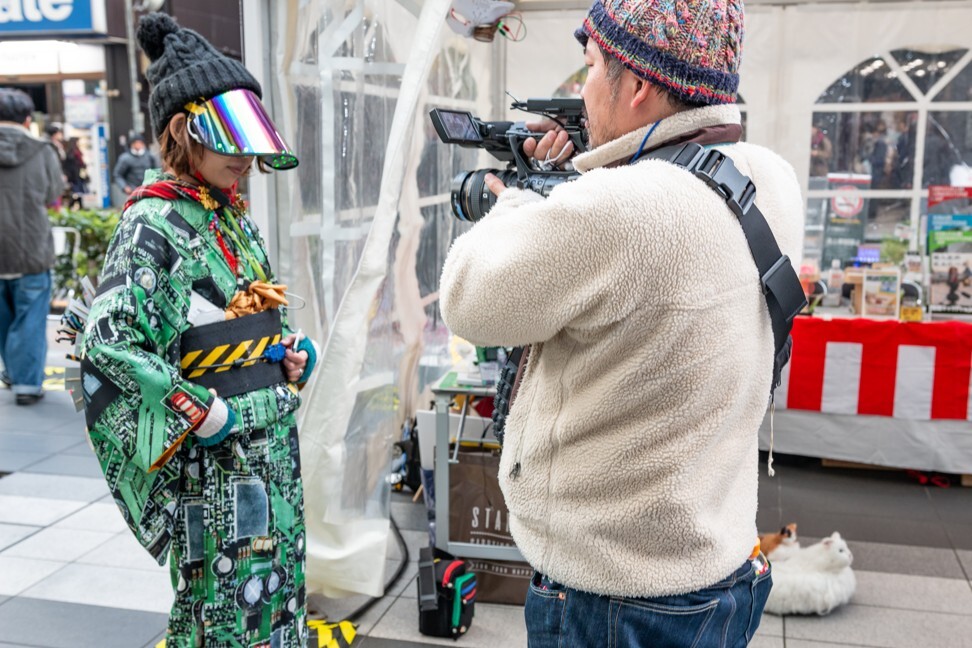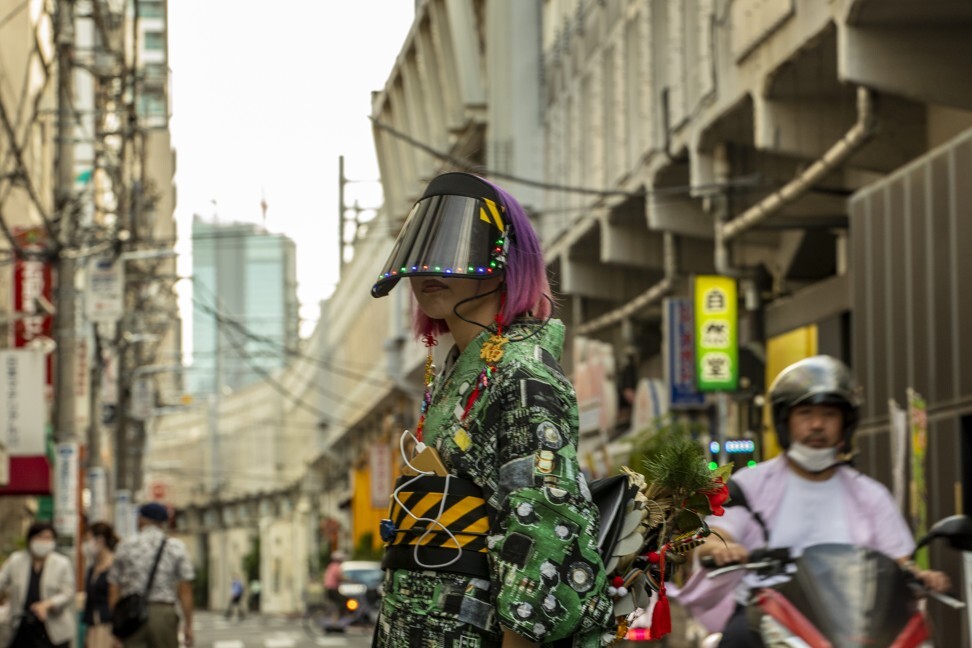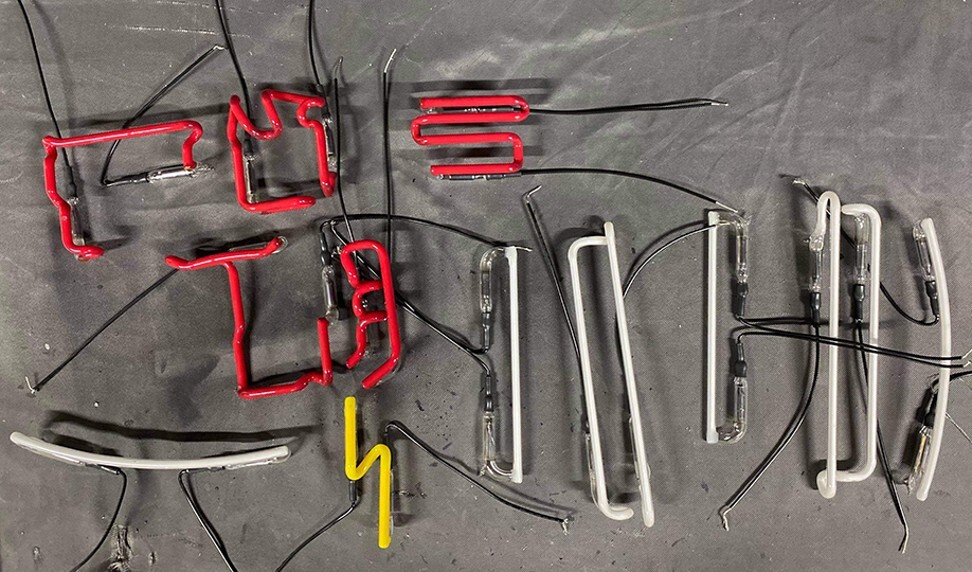
She’s breaking all the rules: Cyber Okan defies ‘kimono patrols’ in Tokyo and sews them using everything from neon lights to computer prints
- The graphic designer loves the traditional kimono but, afraid of kimono purists who will criticise those wearing them wrong, ‘only ever wore ordinary clothes’
- Then she decided to put her spin on the quintessentially Japanese garment, adding LED and neon lights to it and using futuristic prints – and regrets nothing
Even amid the constant hustle and bustle of Tokyo’s Akihabara district, with its dazzling lights in all the colours of an electric rainbow, Cyber Okan stands out.
The “obi” – the belt around her waist – is made up of the black-and-yellow angled stripes more often seen at the site of an industrial accident, and her face is obscured by one of the dark visors worn by middle-aged women in the summer as they try desperately to avoid a tan. This one has been modified with a row of glowing green lights around the edge.
Even that, though, is not the most eye-catching part of her fashion ensemble – strapped to her back is a see-through cube containing two blazing scarlet neon characters for “den no”, meaning computer.
“Ever since I was a child, I have loved the style and grace of the traditional kimono,” she says. “Unfortunately, the kimono is very difficult to put on and wear perfectly and, often when someone is wearing one, kimono purists – known as ‘kimono patrols’ – approach them and criticise the way that it is being worn.
Photographer’s neon vision – if only Hong Kong looked this way now
“I have seen them become really quite angry if they decide that the person wearing the kimono is not wearing it appropriately or in a different way. It was so bad that when I was younger, I was very afraid of being picked on by a kimono patrol, so I only ever wore ordinary clothes.”
After completing high school in Osaka in Japan’s Kansai region, Cyber Okan studied graphic design and joined a local company, but felt more drawn to science fiction, anime and fashion – although she was reluctant to wear her fashion heart on her sleeve.

“Many people in Japan don’t like clothes that they consider to be ‘strange’ and I guess I was afraid of being disliked. But then, two years ago, I discovered that I could pair LED [light-emitting diode] panels or neon signs with a kimono of my own design. I was tired of being worried about the kimono patrol, so I decided to do my own thing,” she says.
“Japan’s traditions are great, but I decided that only sticking to the old way of doing things narrows our horizons. I wanted to make and wear something that is a long way away from the traditional way of wearing a kimono and – very importantly – I wanted to enjoy myself.”
She first chose to attach LED panels to the rear of the kimono in the place of the obi, depicting changing images, patterns or characters.

Since discovering this new form of self-expression, she has looked for places to buy the materials for her quirky designs. The green-and-computer fabric design was from a specialist digital printing outlet with a catalogue of more than 7,000 patterns, she said – but she was the very first to purchase that particular design.
“Bringing in the science-fiction element, which is a big part of me, it fits perfectly with my world view,” she explains. As well as the electronic or neon obi and souped-up sun visor, Cyber Okan also carries a purse made of kimono fabric and a traditional fan.
Although her creations initially incorporated LED screens, she has since experimented with old-school neon.

“The LED screen was very well received, but I felt that the world today is full of LEDs and I wanted to use old-fashioned neon, in the same way it was used in cyberpunk science fiction stories that I know,” she says.

The demise of neon in Japan means that there are only around 50 craftsmen left in the country making neon signs. Cyber Okan works with the artisans at Aoi Neon in Tokyo to create portable signs. One sign takes about three weeks to complete and she has a collection of around eight at present.
Appropriately, she chooses to show off her designs surrounded by some of the bright lights of Tokyo that have been her inspiration.
“I usually go to Akihabara to wear my kimono, or sometimes Shinjuku or Shibuya,” she said. “Akihabara has dozens of tiny electronics parts stores in the backstreets, there are maid cafes, advertisements for anime characters. I think it’s the most cyberpunk district of Tokyo.”

Designing and wearing a futuristic kimono has also had an unexpected effect on Cyber Okan, she admits.
“It has made me understand that I enjoy experiencing Japanese scenery and the sensations that are unique to this country much more than I realised,” she said.

